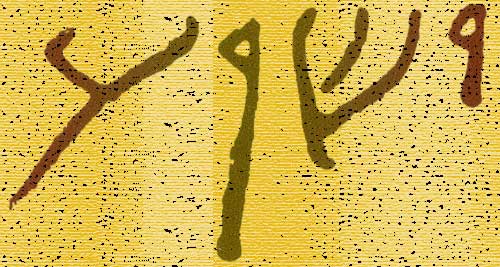10. Aristarchus--a Macedonian of Thessalonica
(Ac 27:2),
who was dragged into the theater at Ephesus, during the tumult with
Gaius, they being "Paul's companions in travel." He accompanied Paul to
Asia
(Ac 20:4),
and subsequently
(Ac 27:2)
to Rome. He was now at Rome with Paul (compare
Phm 23, 24).
As he is here spoken of as Paul's "fellow prisoner," but in
Phm 24
as Paul's "fellow laborer"; and vice versa, Epaphras in
Phm 23,
as his "fellow prisoner," but here
(Col 1:7)
"fellow servant,"
MEYER in
ALFORD,
conjectures that Paul's friends voluntarily shared his imprisonment by
turns, Aristarchus being his fellow prisoner when he wrote to the
Colossians, Epaphras when he wrote to Philemon. The Greek for
"fellow prisoner" is literally, fellow captive, an image from
prisoners taken in warfare, Christians being "fellow soldiers"
(Php 2:25;
Phm 2),
whose warfare is "the good fight of faith."
Mark--John Mark
(Ac 12:12, 25);
the Evangelist according to tradition.
sister's son--rather, "cousin," or "kinsman to Barnabas"; the
latter being the better known is introduced to designate Mark. The
relationship naturally accounts for Barnabas' selection of Mark as his
companion when otherwise qualified; and also for Mark's mother's house
at Jerusalem being the place of resort of Christians there
(Ac 12:12).
The family belonged to Cyprus
(Ac 4:36);
this accounts for Barnabas' choice of Cyprus as the first station on
their journey
(Ac 13:4),
and for Mark's accompanying them readily so far, it being the country
of his family; and for Paul's rejecting him at the second journey for
not having gone further than Perga, in Pamphylia, but having gone
thence home to his mother at Jerusalem
(Mt 10:37)
on the first journey
(Ac 13:13).
touching whom--namely, Mark.
ye received commandments--possibly before the writing of this
Epistle; or the "commandments" were verbal by Tychicus, and
accompanying this letter, since the past tense was used by the
ancients (where we use the present) in relation to the time which it
would be when the letter was read by the Colossians. Thus
(Phm 19),
"I have written," for "I write." The substance of them was, "If he come
unto you, receive him." Paul's rejection of him on his second
missionary journey, because he had turned back at Perga on the first
journey
(Ac 13:13; 15:37-39),
had caused an alienation between himself and Barnabas. Christian love
soon healed the breach; for here he implies his restored confidence in
Mark, makes honorable allusion to Barnabas, and desires that those at
Colosse who had regarded Mark in consequence of that past error with
suspicion, should now "receive" him with kindness. Colosse is only
about one hundred ten miles from Perga, and less than twenty from the
confines of Pisidia, through which province Paul and Barnabas preached
on their return during the same journey. Hence, though Paul had not
personally visited the Colossian Church, they knew of the past
unfaithfulness of Mark; and needed this recommendation of him, after
the temporary cloud on him, so as to receive him, now that he was about
to visit them as an evangelist. Again, in Paul's last imprisonment, he,
for the last time, speaks of Mark
(2Ti 4:11).
JFB.
The Book of Colossians
Colossians 1:16 - For by him were all things created, that are in heaven, and that are in earth, visible and invisible, whether [they be] thrones, or dominions, or principalities, or powers: all things were created by him, and for him:
Colossians 2:15-17 - [And] having spoiled principalities and powers, he made a shew of them openly, triumphing over them in it. Let no man therefore judge you in meat, or in drink, or in respect of an holyday, or of the new moon, or of the sabbath [days]: Which are a shadow of things to come; but the body [is] of Christ.
Colossians in The New Testament - A Brief Overview

Painting of Paul the Apostle by Rembrandt - 1657
Introduction to The Book of Colossians
Brief Summary. Paul had been imprisoned at Rome and received messages about heresies at the church in Colossae. Paul defended the faith by exalting the person of Jesus, and clarifying the true doctrine of Jesus Christ.
Summary of The Book of ColossiansPurpose. The purpose of Paul's epistle to the Colossians is to instruct the believers that salvation is only in Jesus Christ. The person of Jesus Christ must be understood accurately and that "He is the image of the invisible God and in Him all the fulness of the Godhead dwells in bodily form (Colossians 1:15, 19). When Jesus died on the cross he put an end to the civil and ceremonial laws of Judaism. Believers can trust in the finished work of Jesus Christ, our God and creator.
Contents. The epistle to the Colossians contains Paul's instruction about the new life in Christ which comes through a spiritual union with Christ in heaven. This new life produces a Christlike character: brotherly affection, forgiveness, peace, worship and ministry, devotion to Christ, and thankfulness in everything.
Colossae. The city of Colossae was in the heart of New Testament Asia about a hundred miles east of Ephesus, in the Lycus River Valley, in southern Phrygia Colossae was situated on the great highway which ran from Ephesus to the Euphrates Valley, near Hierapolis and Laodicea. According to Colossians 4:12-15 the church had been established in Colossae some time earlier and was Paul sternly warns the church regarding angel-worship, especially that of Michael the Archangel.
The Church at Colossae. Paul does not name himself as the founder of the church at Colossae, yet since he passed through the region of Phrygia (Acts 16:6; 18:23) which the city of Colossae was a part of, it may be assumed that Paul came there and preached Christianity.
The Heresy. The Church at Colossae was being severely attacked by false teachers. The heresy contained many false teachings which included: a false view of the universe, matter is evil, a distortion of man, sin is physical not spiritual, abstaining from foods and asceticism, a misunderstanding of the person of Jesus Christ and the Logos, the worship of angels, and elements of Judaism mixed with Christianity.
Authorship. The epistle to the Colossians was written by Paul the Apostle and included with his prison epistles.
Date. Colossians was written from Rome during Paul's first imprisonment, about 61-62 AD.
Outline of the Book of Colossians
Jesus Christ Exalted - Chapter 1
Christianity Exalted - Chapters 2
Union with Christ Exalted - Chapter 3-4

The Name Jesus In Ancient Hebrew Text
"Yeshua" in First Century Hebrew Text. This is how the name "Jesus"
would have been written in ancient Hebrew documents. The four letters or
consonants from right to left are Yod, Shin, Vav, Ayin (Y, SH, OO, A).
Jesus is the Greek name for the Hebrew name Joshua or Y'shua which means
"The LORD or Yahweh is Salvation".
Colossians Maps and Resources
Map of the Roman Empire (14 A.D.) - This map reveals the Roman Empire during the time shortly after the birth of Jesus, in 14 AD at the time of the death of Augustus. The order which prevailed in this extensive empire, the good military roads, and the use of Koine Greek as the general language of culture throughout the area were among the factors which multiplied the rapid spread of the Gospel of Jesus Christ. (Color Map)
Map of Paul's First Missionary Journey (48 A.D.) - This map reveals the areas in Asia Minor where Paul visited in his first missionary journey. Around 48 AD, in the springtime, Paul and his companions Barnabas and Mark were sent on a mission from the church in Antioch. This would be the first of Paul's Missionary Journey's. (Color Map)
Map of Paul's Second Missionary Journey (51 A.D.) - This map reveals the areas in Asia and Greece where Paul visited in his second missionary journey. Paul re-visits a couple cities in Asia, one of which was Lystra where he was stoned and left for dead a few years earlier. He later has a vision that leads him over to Greece and Paul and his companions travel and minister in various cities in Greece (Philippi, Thessalonica, Berea, Athens and Corinth. Later Paul returns to Ephesus and finally to Caesarea and Antioch. (Color Map)
Map of Paul's Third Missionary Journey (54 A.D.) - This map reveals the areas in Asia and Greece where Paul visited in his third missionary journey. On Paul's third missionary journey he returned to the cities he had first visited on his first missionary journey. During this time he decided to remain in Ephesus for about 3 years, and this city was the main focus of his activities and an important Christian community (Acts 19). (Color Map)
Map of the New Testament World - This map reveals the "Nations" within the ancient world during the first century A.D., the time of the New Testament. The map includes the areas of Israel, Asia, Greece, and Italy. (Color Map)
Map of New Testament Asia - This map shows the cities within
Asia Minor during the first century A.D., the time of the New
Testament. The map includes the principal cities of Asia
including Tarsus, Ephesus, and Colossae, and provinces like
Galatia and Pamphilia. (Color Map)